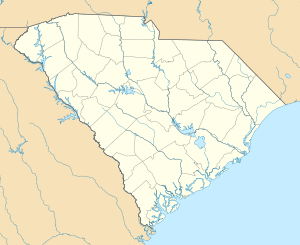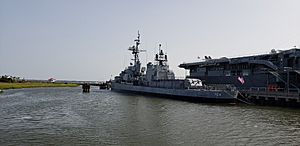USS Laffey (DD-724) facts for kids
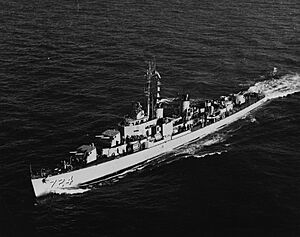
USS Laffey in 1959
|
|
Quick facts for kids History |
|
|---|---|
| Name | Laffey |
| Namesake | Bartlett Laffey |
| Builder | Bath Iron Works |
| Laid down | 28 June 1943 |
| Launched | 21 November 1943 |
| Sponsored by | Ms. Beatrice F. Laffey |
| Commissioned | 8 February 1944 |
| Decommissioned | 30 June 1947 |
| Recommissioned | 26 January 1951 |
| Decommissioned | 9 March 1975 |
| Stricken | 9 March 1975 |
| Identification | |
| Honors and awards |
See Awards |
| Status | Museum ship at Patriots Point, South Carolina |
| Badge | 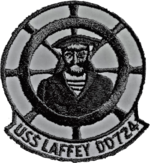 |
| General characteristics | |
| Class and type | Allen M. Sumner-class destroyer |
| Displacement | 2,200 long tons (2,235 t) |
| Length | 376 ft 6 in (114.76 m) |
| Beam | 40 ft (12 m) |
| Draft | 15 ft 8 in (4.78 m) |
| Installed power | 60,000 shp (45,000 kW) |
| Propulsion |
|
| Speed | 34 knots (63 km/h; 39 mph) |
| Range | 6,500 nmi (7,500 mi; 12,000 km) at 15 knots (28 km/h; 17 mph) |
| Complement | 336 |
| Sensors and processing systems |
Radar |
| Armament |
|
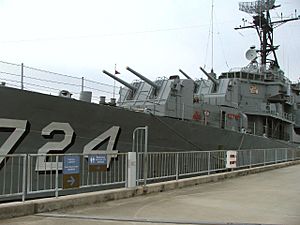
Laffey in 2007
|
|
| Nearest city | Mount Pleasant |
| Built | 1943 |
| Architect | Bath Iron Works |
| NRHP reference No. | 83002189 |
| Significant dates | |
| Added to NRHP | 12 April 1983 |
| Designated NHL | 14 January 1986 |
The USS Laffey (DD-724) is a famous destroyer ship from World War II. She was built in 1943 and joined the United States Navy in February 1944. This ship was named after Bartlett Laffey, a brave sailor who received the Medal of Honor during the Civil War.
Laffey earned the nickname "The Ship That Would Not Die." This was because of her amazing survival during the D-Day invasion and a fierce attack at the Battle of Okinawa. She faced many enemy planes and kept fighting.
Today, Laffey is a special U.S. National Historic Landmark. You can visit her as a museum ship at Patriots Point in Charleston, South Carolina.
Contents
The ship's main structure, called the keel, was started on June 28, 1943. This happened at Bath Iron Works in Bath, Maine. Laffey was launched into the water on November 21, 1943. Ms. Beatrice F. Laffey, the daughter of the sailor the ship was named after, was her sponsor. The ship officially joined the Navy on February 8, 1944. Commander Frederick Becton was her first captain.
Laffey in World War II
After training, Laffey sailed to Bermuda in March 1944. She then became a school ship at Naval Station Norfolk. Later, she joined a group of ships heading to England on May 14. She arrived in Plymouth, England, on May 27.
D-Day Invasion
Laffey quickly got ready for the invasion of France. On June 3, she helped escort other ships to the Normandy beaches. They arrived off Utah beach on D-Day, June 6, 1944. Laffey protected the area and fired at enemy gun positions.
On June 12, Laffey chased enemy E-boats that had attacked another destroyer. She broke up their formation, stopping more attacks. After her duties, she returned to England.
Battle of Cherbourg
On June 25, Laffey joined a group of ships to shell enemy defenses at Cherbourg-Octeville. Shore batteries fired back, hitting other destroyers. Laffey was hit by a shell above the waterline. Luckily, it did not explode and caused little damage.
The group then sailed to Belfast, Northern Ireland. Laffey returned home to Boston on July 9. After repairs, she sailed to Pearl Harbor in September.
Pacific Operations
In October, Laffey joined Task Force 38 in the Philippines. This group was attacking enemy ships and airfields. On November 11, she rescued a wounded Japanese pilot. She returned to Ulithi on November 22.
Laffey then went to Leyte Gulf to protect larger ships. She helped with landings at Ormoc Bay and fired at enemy troops. In January 1945, she supported landings in the Lingayen Gulf area of Luzon. In February, she helped Task Force 58 with air strikes on Tokyo and supported Marines fighting on Iwo Jima.
On March 21, Laffey sailed with Task Force 54 for the Battle of Okinawa. She helped capture Kerama Retto, fired at enemy bases, and protected other ships.
The Kamikaze Attack
On April 15, 1945, Laffey was on radar picket station 1, about 30 miles north of Okinawa. She helped fight off an air attack, shooting down 13 enemy planes. The next day, April 16, 1945, the Japanese launched a huge attack with about 50 planes.
- At 8:30 AM, several Aichi D3A dive bombers attacked Laffey. Her guns shot down many of them. One plane hit the deck but crashed into the sea. Another crashed into a gun mount, killing three men and starting a fire.
- More planes attacked, hitting the ship with bombs and crashing into her. One bomb jammed Laffey's rudder, making it hard to steer.
- American FM-2 Wildcats and Vought F4U Corsair fighters arrived to help. They bravely fought off the enemy planes, shooting down many kamikazes. One Corsair pilot even crashed into the ship's radar antenna after destroying an enemy plane, but he was rescued.
Laffey was badly damaged by four bombs, six kamikaze crashes, and machine-gun fire. Thirty-two crew members died, and 71 were wounded. Despite the damage, Captain Becton refused to give up the ship. He famously said, "No! I'll never abandon ship as long as a single gun will fire." This showed the incredible spirit of the crew.
After the War
Laffey was towed to Okinawa for temporary repairs. She then sailed to Saipan and later to Tacoma, Washington, arriving on May 24. She spent months in drydock for major repairs.
In September, Laffey had a small collision with another ship in thick fog. She rescued most of the other ship's crew.
She then operated in Hawaiian waters. In May 1946, she took part in Operation Crossroads. This was a series of atomic bomb tests at Bikini Atoll. Laffey collected scientific data. After the tests, she needed extensive cleaning to remove radioactive materials.
Laffey was taken out of service on June 30, 1947. She joined the Pacific Reserve Fleet.
Korean War Service
Laffey was brought back into service on January 26, 1951. She sailed to Korea in March 1952. There, she protected aircraft carriers like Antietam.
In May, Laffey helped with the blockade of Wonsan in Korea. Captain Henry J. Conger, her commander, bravely led the ship in battles against enemy shore guns. His leadership helped the Navy succeed in blocking the Korean coast.
After a short break, Laffey returned to Korea. In June, she sailed back to the east coast of the US, going through the Suez Canal.
Cold War Missions
Laffey operated in the Caribbean and later went on a world cruise in 1954. She visited Korea again and returned to Norfolk in August. She took part in fleet exercises and rescued four people from a sunken schooner.
In November 1956, Laffey went to the Mediterranean during the Suez Crisis. She joined the 6th Fleet to patrol the border between Israel and Egypt. She returned to Norfolk in February 1957.
Laffey made several more trips to the Mediterranean for NATO operations. In 1959, she sailed through the Suez Canal to the Persian Gulf. She spent Christmas in Saudi Arabia before returning home in February 1960.
In January 1961, while in the Mediterranean, Laffey helped the British ship Dara after it had an explosion and caught fire. She continued training and patrols in the Atlantic and Caribbean. Laffey also observed Soviet naval forces during training missions.
Laffey was finally taken out of service for good on March 9, 1975. She was the last of her type, the Sumner-class destroyers, to be decommissioned.
Awards and Honors
Laffey received many awards for her service:
- The Presidential Unit Citation and five battle stars for her bravery in World War II.
- The Korean Presidential Unit Citation and two battle stars for her service in the Korean War.
- The Meritorious Unit Commendation during the Cold War.
- The Battle "E" for excellence in all three conflicts.
In 1986, Laffey was named a National Historic Landmark. This recognized her as the only remaining US-owned Sumner-class destroyer and honored her amazing survival during the kamikaze attack.
Laffey as a Museum Ship
Today, Laffey is a museum ship at Patriots Point in Mount Pleasant, South Carolina. She is docked next to the aircraft carrier Yorktown.
In 2008, officials found over 100 leaks in Laffey's hull. There was concern the ship might sink. The state of South Carolina provided a $9.2 million loan for repairs. On August 19, 2009, she was towed to Detyens Shipyards for drydock repairs. Her rusted hull was fixed with new, thicker metal and fresh paint.
On January 25, 2012, Laffey returned to Patriots Point. Many former crew members were there to welcome her back. It cost $1.1 million to bring her back and prepare her new docking spot at the museum.


